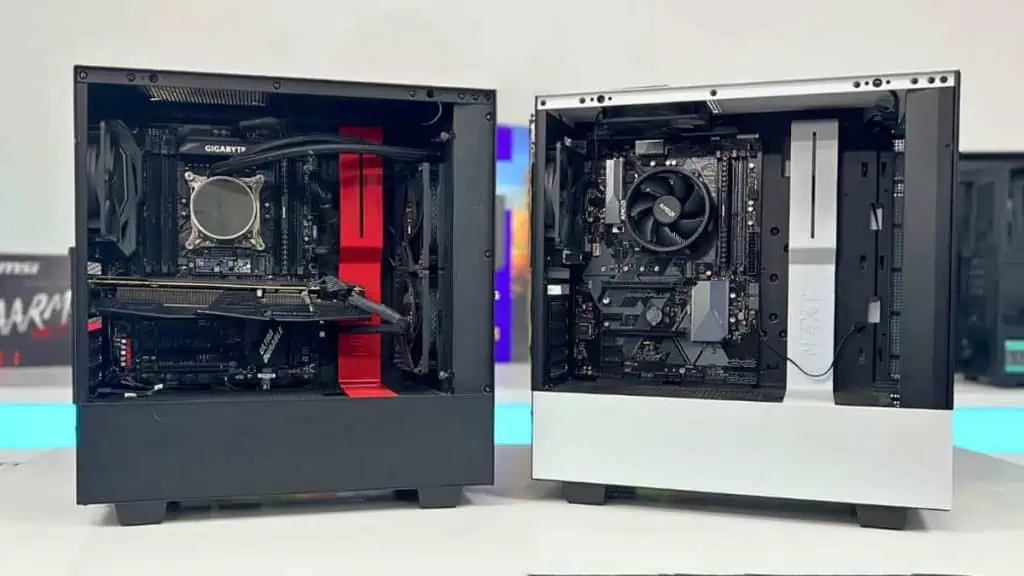To achieve optimal airflow and less dust accumulation, it’s recommended to opt for neutral pressure or slightly leaning towards positive.
With more intake than exhaust fans (or just balanced), dust won’t enter the case from every nook and cranny. Instead, hot air tries to escape from every gap, and the constant air supply keeps the components cool.
That doesn’t mean negative pressure is that terrible. Such a configuration is ideal for users who have dust-free surroundings and whose components overheat excessively.
Let’s get deeper and discuss why a slightly positive pressure is better.
Why I Recommend Slightly Positive Pressure
For beginners, positive pressure is where more air comes in than goes out of the PC case. You can achieve this by installing more intake fans than exhaust.
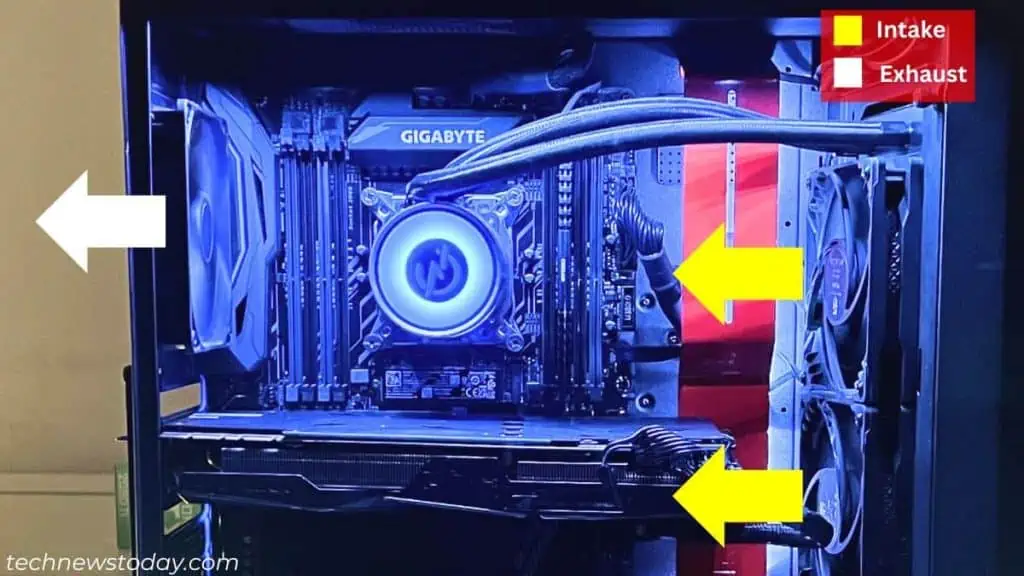
But we don’t want all or too much intake as it leads to difficulty in hot air dissipation. Make sure you install an extra intake fan whenever you go for one exhaust.
In an ideal setup, this means 2 to 3 intake and 1 to 2 exhaust fans. This way, you’ll have a balanced airflow and air pressure slightly leaning toward positive.
In a setup with a balanced number of fans, running the intakes at a higher speed than the exhausts should also do.
This configuration has the following benefits:
Maintains Proper Airflow
When the number of fans is balanced out, the same amount of air that’s brought in from the front or bottom is exhausted from the rear or top.
It does look like that’s the best approach to go for. However, in real-life scenarios, the components’ temperatures rise unexpectedly and require extra effort to throw out hot air.
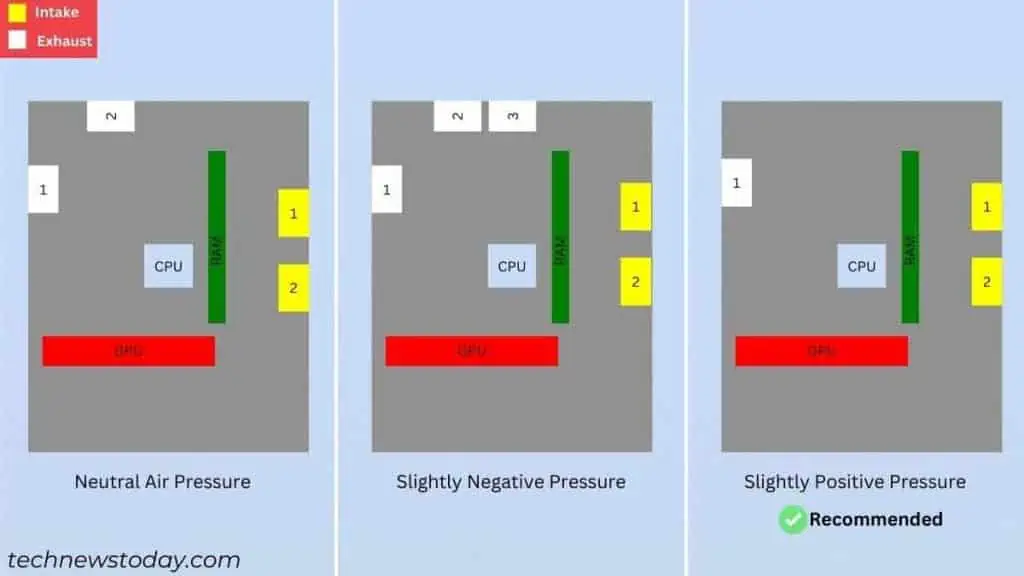
A slightly negative air pressure (with an additional exhaust fan) is a good solution. But again, this creates more chances of dust accumulation in the nooks and crannies.
Going for a slightly positive pressure traps extra air inside the case and the airflow remains balanced.
Less Dust Accumulation
No matter where you’ve placed your PC and how clean your surroundings are, dust is unavoidable.
With fewer exhaust fans in a positive-pressure setup, all the case openings work to push hot air outside, including the dust nearby.
The intake fans directed towards the components are also usually covered by dust filters or perforated materials. So, the chances for dirt and grime to reach inside the chassis are quite low.
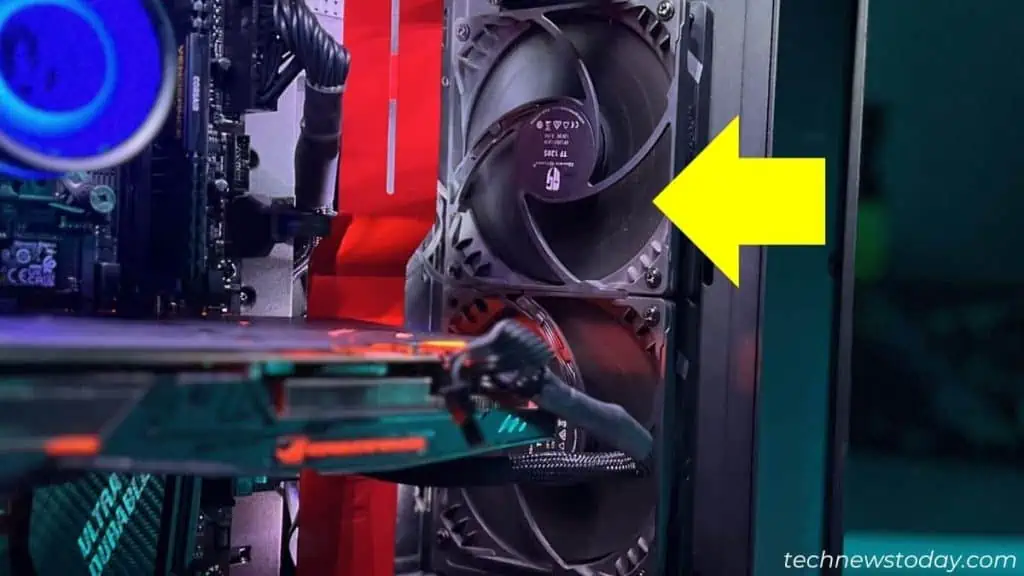
This is exactly the opposite when it comes to negative pressure. With fewer intake fans, the vents act as a vacuum and pull dust inside.
As mentioned earlier, too many intake fans with no or less exhaust is also not good. Since hot air won’t escape properly, the vital components, like the CPU and especially GPU may overheat.
The setup below with AIO has intake radiator fans that create full positive pressure in the setup (so, less dust accumulates). However, with no exhaust fans, I experienced slight overheating when performing heavy tasks.
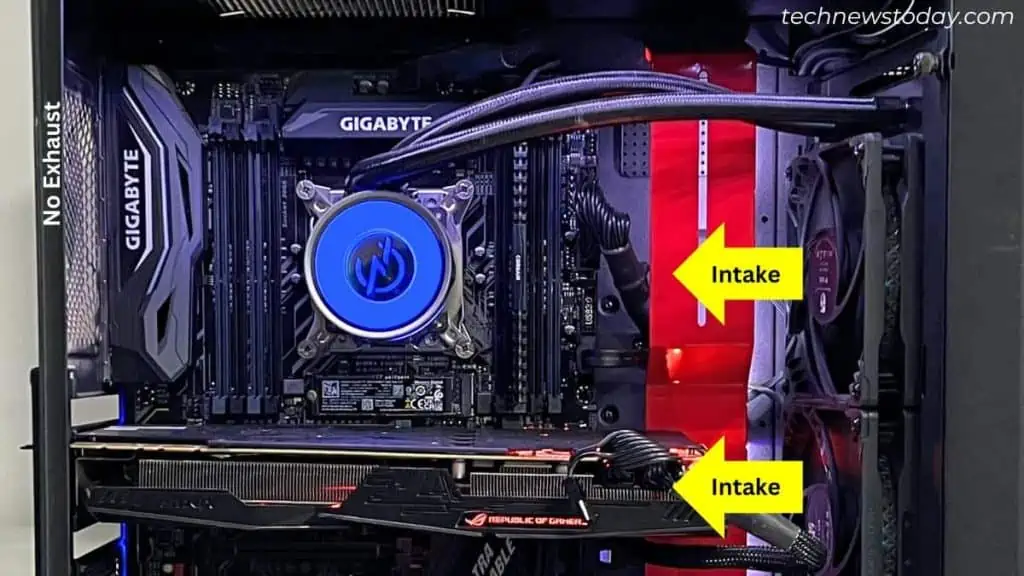
What about neutral air pressure? Well, it has no impact on dust. So, leaning slightly towards the positive is the best bet to avoid dust.
Effortless Maintenance
Since less dust accumulates in a positive pressure setup, you don’t need to frequently clean your PC.
The same case is with the cooling strategy that slightly leans toward positive. It requires less maintenance compared to negative or slightly negative air pressure.
Note: PSU fans are generally faced downwards to suck cool air from outside the case. There’s a separate exhaust fan at the rear, from where the hot air is thrown out. So, it doesn’t affect the pressure and airflow inside the PC case.
Whether it be positive or negative pressure, the dust filters underneath the case and PSU fans are the ones to be the dustiest.
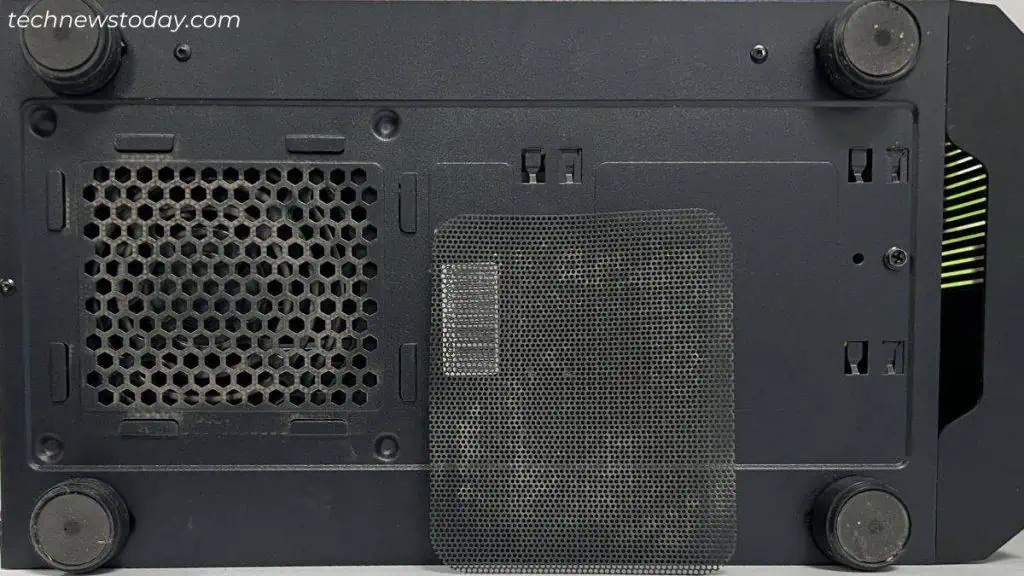
When to Go for Negative Air Pressure
The exact opposite of positive pressure is the negative pressure – less air enters the case and more is dissipated. This is the setup with more number of exhaust fans than intake.
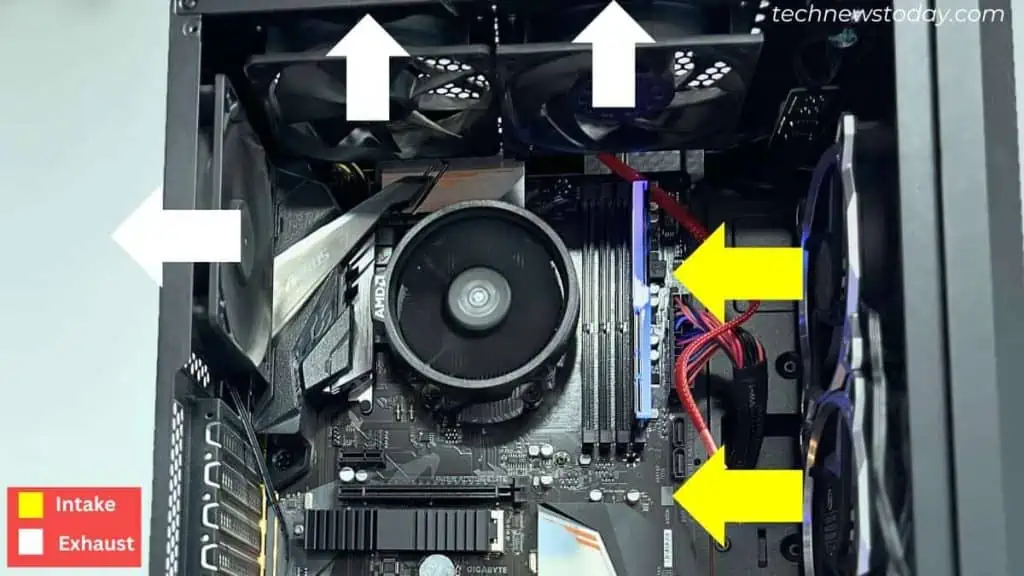
Excessive dust accumulation is the biggest reason you shouldn’t go for such a cooling strategy.
However, modern PC cases are equipped with decent-quality dust filters at the top and rear vents. Dust particles accumulate here before reaching the inside of the chassis.
While dust has become a less of problem these days, you still have to clean the fans and dust filters often.
Negative air pressure is beneficial in terms of cooling the internal components. The exhaust fans dissipate heat much more quickly from the heated parts, which is the major con of positive pressure.
Even Sean and Norm from Tested have performed a smoke experiment claiming that negative pressure is better in terms of hot air dissipation.
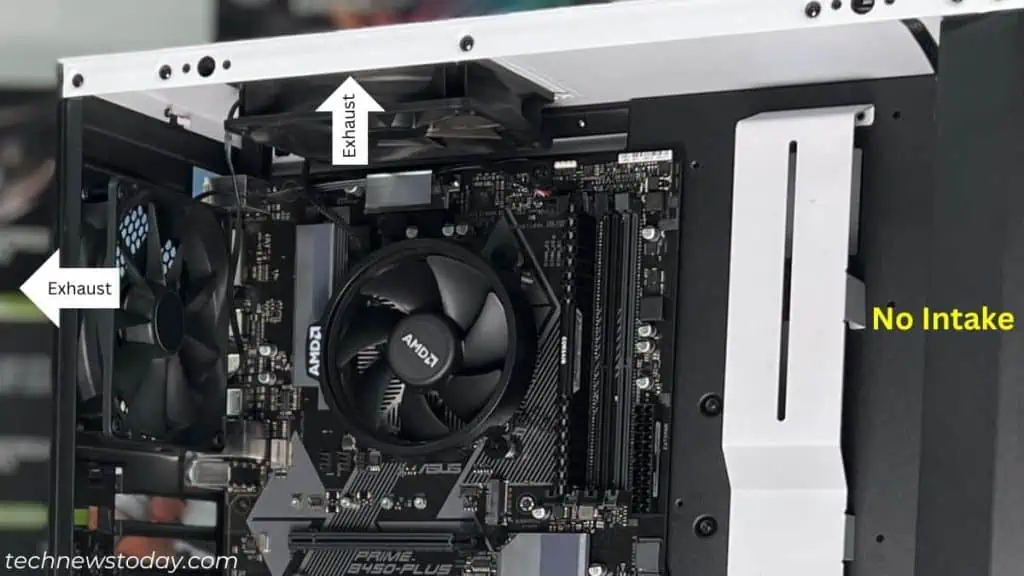
But with no/very few intake fans, the exhausts work against each other. Meaning the nearby vents/openings start to draw the same hot air into the case, affecting the overall airflow efficiency.
Opting for a slightly negative pressure is a great alternative. Just be sure to install the case fans properly and ensure there are no vents near them. This is usually best for the small form factor PC cases.
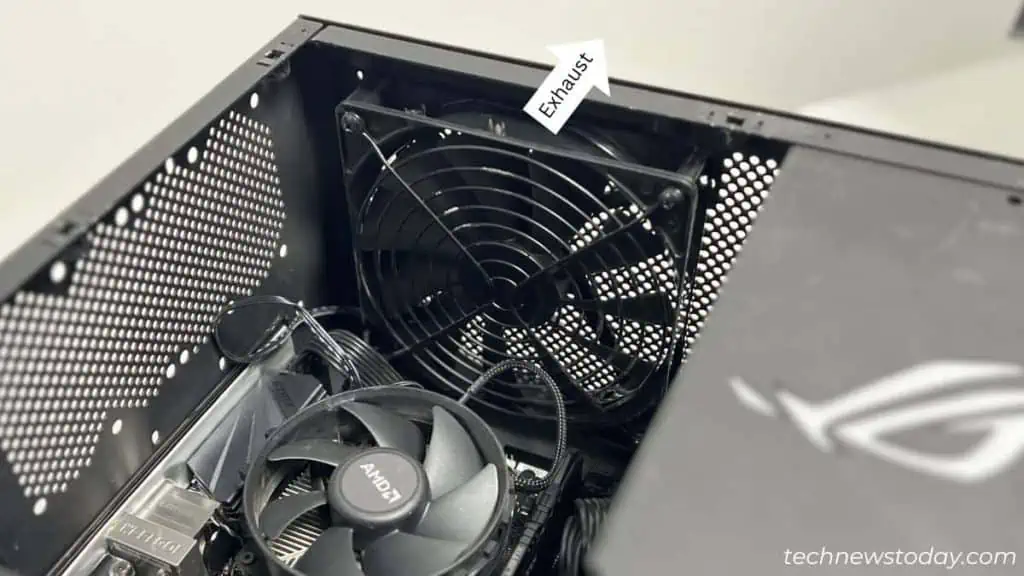
Differences Between Positive and Negative Pressure
Choosing the appropriate airflow strategy completely depends on your setup, environment, and requirements.
To check whether your setup has the desired air pressure, you don’t need a manometer. Place your hand near one of the vents. If you feel that the air is blowing out, this means your PC enclosure has negative pressure.
A better alternative is using incense sticks, like JayzTwoCents does to check whether his setup has balanced airflow.
Here are the main differences between positive and negative air pressure to help you choose the best one for your needs:
| Factor | Positive Air Pressure | Negative Air Pressure |
| Setup | More number of intake fans than exhaust | More number of exhaust fans than intake |
| Airflow | PC housing retains cool air for a longer time | Imbalanced, hot air can reenter the PC case |
| Cooling Efficiency | Average | Better, as it dissipates hot air away from the heated components |
| Dust Buildup | Vents and openings will work as exhaust and thus the dust is pushed | Vents and opening work as a vacuum, which leads to more dust accumulation inside the chassis (if filters aren’t used) |
| Component Longevity | Less dust buildup means higher longevity | More dust buildup if not cleaned on time can degrade your PC’s lifespan in the long run |
Final Things to Consider
Anyone who is experiencing high temperatures at all times should install one exhaust fan more than the intake (to achieve slightly negative pressure). But along comes the challenge of dust and frequent cleaning.
Otherwise, neutral leaning towards slight positive air pressure is appropriate for most users. It leads to better airflow and less dust accumulation.
This is a never-ending debate and as I mentioned earlier, picking one completely depends on user needs and the components used.
Here are the other factors that should be considered for optimizing cooling and airflow:
- Besides the number of intake and exhaust, fan size also matters. Picking different sizes may lead to exactly the opposite air pressure you desire.
- Configuring the fan speed curve manually is a great alternative to optimize the airflow. While at it, make sure you achieve better cooling with less noise production.
- Cooling also depends on the type of PC case used. I always recommend going for the best airflow cases whether you want a positive or negative pressure.
- When choosing case fans, it also matters whether the fans are for higher airflow or static pressure.
Higher airflow fans have greater CFM ratings and can push/pull air efficiently. On the other hand, static pressure fans work better in PC cases with airflow restrictions.

